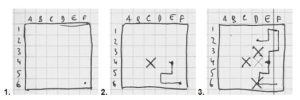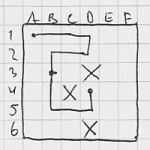Competitive skirmish 1 vs 1 game. Gameplay is about tactics and strategy without any luck.
The heart of “Abstics” lies in its deep tactical gameplay. Players must assess the battlefield and anticipate their opponent’s moves. The absence of luck-based mechanics ensures that victory is a direct result of a player’s ingenuity and strategic thinking. Every move counts – from the placement of the units to the timing of attacks, every aspect of the game demands careful consideration.
Abstics also offers a diverse array of scenarios and mission objectives. Players will for example:
QUBE (Quick and Universal Battle Engine) is a RPG engine designed specifically for mechanic-driven RPG games. At its core, QUBE revolves around a very simple ruleset, making it accessible to both seasoned RPG enthusiasts and newcomers. The engine focuses on mechanics that drive the gameplay forward, ensuring that players stay engaged in action and immersed in the game world.
The battle system in QUBE is the heart of the engine, designed to deliver quick but strategic combat experiences. It employs a turn-based approach, where players and enemies take turns executing actions (using their Action Points).
QUBE also supports a rich inventory and equipment system, allowing players to collect and manage various items, weapons, armor, and other gear. These items can enhance the characters’ abilities, provide unique bonuses, and offer tactical advantages in battles.
My goal in making QUBE is to make RPG engine that prioritizes simplicity, flexibility, and engaging mechanics.
TBD
It’s an abstract logic-strategy game with no random elements. The goal of each player is to get the main piece to the opposite side of the board or capture the opponent’s boss while keeping his. There are three types of pawns in the game, each with a different way of moving. Some glide as if on ice, others jump and the boss moves one field, but he can jump over his pawns.
Player can win the game by completing one of objectives:
Board consists of a grid made of triangles:
Pawns:
Master Pawn: The most important pawn on the board. Start in the middle field on the bottom side. Can move to neighboring fields but not on wall fields or backward unless making a controlling triangle. Can jump over allies but cannot move backward during a jump. Can capture enemy pawns within its movement range.
Glider Pawn: Two glider pawns start on the left side from the master pawn. Glides through neighboring fields until it hits a wall, another pawn, or the board border. Stops on a stop field. Cannot stop by itself or jump over other pawns. Can capture enemy pawns within its movement range.
Jumper Pawn: Two jumper pawns start on the right side from the master pawn. Jumps on corner-adjacent fields of the same color as the field it stands on. Cannot jump on walls or own pawns. Captures enemy pawns by jumping on them.
Starting Setting:
First player is selected randomly. In players turn he must move one of his pawns. Every pawn moves and takes enemy’s pawns according to their description. Taking enemy’s pawn isn’t compulsory. After taking, attacker stops on field that used to be occupied by taken pawn. After taking enemy’s Master pawn, enemy looses and takes all his pawns off the board. If Master pawn gets to the row on the opposite board border player wins.
The game requires strategic moves and capturing opportunities while protecting your master pawn.
My roles:
Blind Tanks is a simple pen & paper game where your goal is to shoot down your opponent’s tank. It is similar to ships, but logical thinking is much more important than luck.
Preparation
The players draw (on a squared sheet of paper, each on their own, invisible to the opponent) a 6×6 field frame and mark the top of the column: ABCDEF and the rows on the left: 123456. First player starts at A1 and second form F6. Everyone puts a dot at the starting point.
Round
Each player has the choice of either move or shoot.
Movement
The player moves his tank to an adjacent square by drawing a line connecting the centers of the squares. He then says “move” – which means he has made a move and ends his turn.
Movement rules:
Shoot
Each shot hits exactly 2 squares away from the shooter (in the chosen direction). For example, from E4 you can shoot at E2, C4 and E6 (in this case you cannot shoot to the right of the tank). The player declares a shot by saying “shot C4”. The opponent sees only the place of the shot and reacts by saying “miss” or “hit”.
If there is no opponent in the target square (miss), it is marked (X). This field cannot be entered or shot at.
If there is an opponent in the target square (hit), the shooting player wins.
The game is about guessing where the opponent may be. At the moment of the shot, it can be in 4 places – 2 squares up / down or to the right / left of the hit spot.
Gameplay example

Enemy movement:
